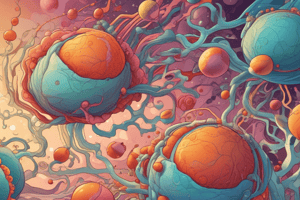Podcast
Questions and Answers
Which phase of glycolysis involves the consumption of ATP?
Which phase of glycolysis involves the consumption of ATP?
- Investment phase (correct)
- Both investment and yield phases
- Yield phase
- Neither investment nor yield phase
How many hydrogen atoms are contributed overall by the two phosphate (Pi) groups in glycolysis?
How many hydrogen atoms are contributed overall by the two phosphate (Pi) groups in glycolysis?
- 4
- 2 (correct)
- 3
- 1
What makes the overall reaction of glycolysis appear unbalanced with respect to oxygen atoms, hydrogen atoms, and charges?
What makes the overall reaction of glycolysis appear unbalanced with respect to oxygen atoms, hydrogen atoms, and charges?
- Ionic bond formation
- Difference between ADP and ATP
- Hydrolysis of glucose
- Dissociation of phosphate (Pi) groups (correct)
What tends to exist in an ionic bond with ADP3− in the cellular environment?
What tends to exist in an ionic bond with ADP3− in the cellular environment?
In which phase of glycolysis is more ATP produced than originally consumed?
In which phase of glycolysis is more ATP produced than originally consumed?
Which phase of glycolysis involves the production of more ATP than originally consumed?
Which phase of glycolysis involves the production of more ATP than originally consumed?
What is the overall reaction of glycolysis?
What is the overall reaction of glycolysis?
How are charges balanced in the overall reaction of glycolysis?
How are charges balanced in the overall reaction of glycolysis?
What contributes to the atom balance in the overall reaction of glycolysis?
What contributes to the atom balance in the overall reaction of glycolysis?
In the cellular environment, what ion tends to exist in an ionic bond with ADP3−?
In the cellular environment, what ion tends to exist in an ionic bond with ADP3−?
Flashcards
Glycolysis Investment Phase
Glycolysis Investment Phase
The phase of glycolysis where ATP is used.
Hydrogen atoms from Phosphate groups
Hydrogen atoms from Phosphate groups
Two phosphate (Pi) groups in glycolysis contribute 2 hydrogen atoms.
Glycolysis Oxygen Imbalance
Glycolysis Oxygen Imbalance
The overall glycolysis reaction appears unbalanced in oxygen, hydrogen, and charge due to phosphate dissociation.
ADP and Mg2+
ADP and Mg2+
Signup and view all the flashcards
Glycolysis Yield Phase
Glycolysis Yield Phase
Signup and view all the flashcards
Overall Glycolysis Reaction
Overall Glycolysis Reaction
Signup and view all the flashcards
Charge Balance in Glycolysis
Charge Balance in Glycolysis
Signup and view all the flashcards
Phosphate Groups in Glycolysis
Phosphate Groups in Glycolysis
Signup and view all the flashcards
Mg2+ and ADP
Mg2+ and ADP
Signup and view all the flashcards
ATP in Glycolysis
ATP in Glycolysis
Signup and view all the flashcards
Study Notes
Overview of Glycolysis
- Glycolysis is a metabolic pathway that converts glucose (C6H12O6) into pyruvate
- Occurs in the liquid part of cells, the cytosol
- Releases free energy used to form high-energy molecules ATP and NADH
Characteristics of Glycolysis
- Sequence of ten reactions catalyzed by enzymes
- Ancient metabolic pathway, widely occurring in other species
- Can occur in oxygen-free conditions, catalyzed by metal ions
Types of Glycolysis
- Embden–Meyerhof–Parnas (EMP) pathway: most common type, discovered by Gustav Embden, Otto Meyerhof, and Jakub Karol Parnas
- Other pathways: Entner–Doudoroff pathway, heterofermentative and homofermentative pathways
Studying That Suits You
Use AI to generate personalized quizzes and flashcards to suit your learning preferences.




